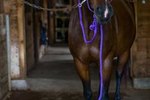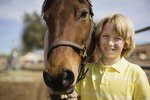
It’s discomforting to have your horse move like a squirmy toddler during saddling. Fixing it requires your awareness that your horse’s movements make sense to her. Either she’s communicating to you or she believes she's doing what you expect and want. Don’t punish her or unwittingly reward the behavior by not saddling her. Investigate causes and help her change the way she thinks about saddling.
Instincts
The concept of saddling goes against a horse’s natural instincts -- as a prey animal, having anything on her back is akin to death and thus avoided. A horse should be properly “sacked out” before a saddle ever touches her back. This means rubbing her body with objects: Hands, ropes, sacks, tarps and blankets are common. When she moves, you ask her to move in a different manner, such as backing up if she moves forward. She learns to pay attention to you regardless of her fear of something on her back. When she has stood still, remove the object. Don’t forget to rub her girth area, where the cinch will go. If your horse hasn’t had this experience, she may still instinctively move.
Saddling Pain
If you haven’t had your saddle professionally fitted for your horse, do so. Pain from an ill-fitting saddle can lead to long-term physical problems. If your horse equates the saddle with pain, moving during saddling is her way of communicating to you: “I don’t know how else to tell you this hurts. Please don’t put that on me.” If she moves only when you’re tightening the cinch, remember this tightening also increases pressure from the saddle; or, perhaps her ribs hurt. Never tighten a cinch too fast or too tight.
Past Career
Some equine careers require a horse to “hurry up and go,” and that becomes such a horse's mindset. It takes retraining to change that way of thinking. Racehorses are a perfect example. Race owners, trainers and jockeys want racehorses to be constantly in motion when preparing to race, and that includes the saddling process. Otherwise, it may also be a habit that a previous owner never corrected. In these cases, you can’t punish your horse for doing what has always been perfectly acceptable. Instead, praise and reward her every time she stands still. Eventually, you’ll retrain her to what you want and expect from her.
Riding Issues
It may be hard to admit, but something about your riding may cause your horse apprehension. She knows the saddle means you’re about to ride her -- and if that’s not an enjoyable experience for her, she’ll resist it. Some common riding skills issues include tense hands or pulling the reins too hard, hitting her back during the sitting trot or canter, and pinching your knees against her sides. She may not like her job. Instead of dressage, maybe she’d prefer jumping. Sometimes just taking a horse out of the arena and onto the trail can be enough of a variety to keep her from getting sour.
References
Resources
Photo Credits
-
BananaStock/BananaStock/Getty Images
Writer Bio
Based in Central Texas, Karen S. Johnson is a marketing professional with more than 30 years' experience and specializes in business and equestrian topics. Her articles have appeared in several trade and business publications such as the Houston Chronicle. Johnson also co-authored a series of communications publications for the U.S. Agency for International Development. She holds a Bachelor of Science in speech from UT-Austin.




